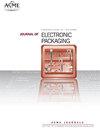基于蠕变应变的球栅阵列构件疲劳预测的代理建模
IF 2.3
4区 工程技术
Q3 ENGINEERING, ELECTRICAL & ELECTRONIC
引用次数: 1
摘要
在过去的几年里,有限元分析已经被证明是一种基于失效物理方法的电子设备疲劳预测的合适方法。为此,在焊点的裂纹易感区域中评估非弹性应变参数,如蠕变应变或蠕变能量密度。由于塑性行为的非线性是这些模拟的基础,因此计算工作量可能很大。这主要导致了以组件为中心的方法。对组件的全局影响,如由于相邻组件、铜迹线或印刷电路板的固定而引起的局部刚度变化,通常被忽略。为了使基于蠕变的疲劳预测适用于复杂的印刷电路板组件,需要建立一种减少计算工作量的方法。为此,已经开发了一种基于机器学习的焊点方法。首先,建立了数据生成和模型训练的流程。然后,讨论了几种降低输入参数的方法。最后,基于生成的模拟数据对第一个模型进行训练。本文章由计算机程序翻译,如有差异,请以英文原文为准。
Surrogate Modeling for Creep Strain Based Fatigue Prediction of a Ball Grid Array Component
In the past years the Finite Element Analysis has proven to be a suitable way for fatigue prediction of electronic equipment based on the Physics-of-Failure-approach. For this, inelastic strain parameters like creep strain or creep energy density are evaluated in crack susceptible regions of solder joints. Due to the non-linearity of the plastic behavior, which is the basis for these simulations, the computational effort can be significant. This mostly leads to a component focused approach. Global influences on components like local stiffness variations due to adjacent components, copper traces or fixations of the Printed Circuit Board are often ignored. To make creep based fatigue predictions suitable for complex Printed Circuit Board Assemblies, a method for reducing computational effort needs to be established. For this matter, a machine learning based approach for solder joints has been developed. First, the process for data generation and model training has been established. Thereafter, several methods for input parameter reduction are discussed. Lastly, a first model is being trained based on the generated simulation data.
求助全文
通过发布文献求助,成功后即可免费获取论文全文。
去求助
来源期刊

Journal of Electronic Packaging
工程技术-工程:电子与电气
CiteScore
4.90
自引率
6.20%
发文量
44
审稿时长
3 months
期刊介绍:
The Journal of Electronic Packaging publishes papers that use experimental and theoretical (analytical and computer-aided) methods, approaches, and techniques to address and solve various mechanical, materials, and reliability problems encountered in the analysis, design, manufacturing, testing, and operation of electronic and photonics components, devices, and systems.
Scope: Microsystems packaging; Systems integration; Flexible electronics; Materials with nano structures and in general small scale systems.
 求助内容:
求助内容: 应助结果提醒方式:
应助结果提醒方式:


